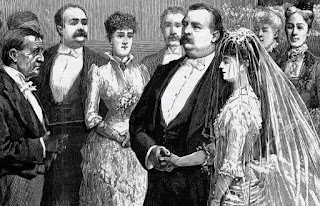GEORGE WASHINGTON (1st president) – Apparently Washington had a special fondness for yellow flowers like Brown-Eyed Susans and Aurinia saxatalis (Basket of Gold). According to this article, he planted so many roses at Mount Vernon that it took 12 days to pick the petals off them (which were then used to make rosewater). He also had a greenhouse there to grow exotic plants and flowers.
JAMES BUCHANAN (15th president) – Unfortunately for Buchanan, he carries a legacy of being one of America’s worst presidents (read more here). But, not everything he did was questionable: He had conservatories built to grow flowers, which in turn began the on-going practice of fresh floral arrangements in the White House. The credit for these actions should not all go to Buchanan. He undoubtedly acted at the behest of his niece Harriet Lane, who served as his surrogate First Lady (he was a lifelong bachelor) and loved flowers.
THEODORE ROOSEVELT ((26th president) – Teddy Roosevelt had the conservatories removed as part of a renovation that included the construction of the now-famous West Wing. It wasn’t that he disliked the plants, he just needed more room for his large family. Flowers for White House events began to be outsourced at this point. Perhaps to compensate for the removal of the conservatories, Roosevelt’s wife, Edith, was given space to create a garden. Her “colonial garden” was where today’s Rose Garden sits. It was filled with paisley-shaped flower beds, heirloom flowers, and wildflowers that she had collected herself from the surrounding countryside. See it here.
JOHN F. KENNEDY (35th president) – Blue Cornflowers seem to have been a particular favorite of JFK; he even wore one on his wedding day. During his tenure at the White House, what had been the colonial garden was renovated to create a space that would serve as both a place of beauty and an outdoor venue for up to 1,000 people. JFK had a vision inspired by French gardens and driven by his love of flowers. Here, in her own words, is how Rachel (“Bunny”) Mellon and JFK made this now-famous garden a reality. There’s a lot of really entertaining details in her story, including, “Why a rose garden?”LYNDON BAINES JOHNSON (36th president) - While LBJ made it a key point in his administration to clean up the environment (we’re still working on that), his wife “Lady Bird” believed in beautifying spaces to create a love and appreciation for where one lives. She appreciated all things floral and this showed in her work in everything from adding wildflowers to the pattern on the presidential china to planting flower beds all over DC and beyond. The work she did was fully supported by LBJ and had conservation benefits far beyond simple beautification. Here’s a short article that gives you the highlights of all that this flowery first lady accomplished.
RONALD REAGAN (40th president) – In 1986, Ronald Reagan signed legislation that proclaimed the rose the national flower. It would seem like a slam-dunk decision (everyone likes roses, right?); but there was actually another candidate presented and fought over as the bill made its way through congress – the marigold. For more on this, go here.
 I’m going to end this here in the 80s. In the years since then, floral designs and the presidential brand they represent have been mostly handled by professional White House florists (with some input from some First Ladies). They do beautiful work, it’s just not as anecdotal.
I’m going to end this here in the 80s. In the years since then, floral designs and the presidential brand they represent have been mostly handled by professional White House florists (with some input from some First Ladies). They do beautiful work, it’s just not as anecdotal.
Take Care.
Submitted by Pam










No comments:
Post a Comment